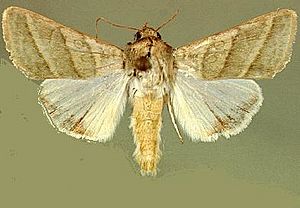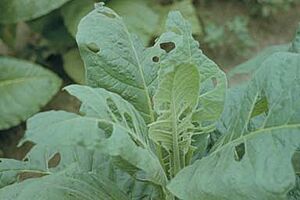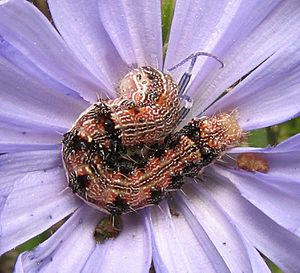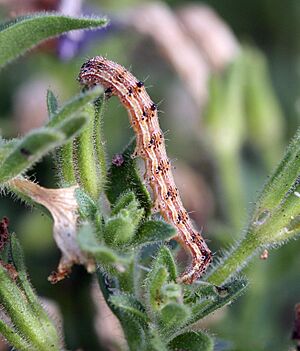Tobacco budworm
Quick facts for kids Tobacco budworm |
|
|---|---|
 |
|
| Scientific classification | |
| Genus: |
Chloridea
|
| Species: |
virescens
|
| Synonyms | |
|
|
The Chloridea virescens, also known as the tobacco budworm, is a type of moth. It belongs to the Noctuidae family. You can find these moths across the eastern and southwestern United States. They also live in parts of Central America and South America.
This moth is a big problem for many farm crops. These include tobacco (which is why it's called a tobacco budworm) and cotton. But it can also live on many other plants. These include fruits, vegetables, flowers, and even weeds. It has been hard to control this pest. One big reason is that it has become resistant to many insecticides and pesticides.
Chloridea virescens used to be in a different group called Heliothis. But in 2013, scientists studied its genes and body parts. They decided to move it to a group called Chloridea.
Contents
What They Look Like
Adult tobacco budworms are brownish. They have a slight green color. Their front wings have three dark stripes. Each stripe has a whitish or cream border. The back wings are whitish with a dark stripe at the end.
Fully grown adults are about 28 to 35 millimeters (1.1 to 1.4 inches) wide when their wings are spread. Female moths are usually darker than males.
Life Cycle
The tobacco budworm goes through four main stages in its life. These are egg, larva (caterpillar), pupa, and adult. Their life cycle usually happens during warmer months. This is from late spring to early fall. The exact time depends on where the budworm lives.
During this time, Chloridea virescens can have about 4 to 5 generations. This also depends on the region. Warmer temperatures make them grow faster. But they also age faster. Colder places make them grow slower. In the southern United States, tobacco budworm moths appear between March and May.
Egg Stage
Female moths usually lay 300 to 500 eggs in nature. But in special lab conditions, they can lay 1000 to 1500 eggs. They lay their eggs on the flowers, fruits, or new growth of plants.
The eggs are first whitish or yellowish. They turn grey as they get older. Eggs are round, about 0.5 to 0.6 millimeters wide. They have a flat bottom where they stick to the plant. There are 18 to 25 ridges that spread out from the top of the egg.
It is very hard to tell tobacco budworm eggs apart from corn earworm eggs. In tobacco budworm eggs, the main ridges stop before reaching the cells around a tiny hole at the top. Corn earworm ridges go all the way to this hole.
Larval Stage
Chloridea virescens larvae (caterpillars) usually shed their skin 5 to 6 times. This is called an instar. Sometimes, they need 7 instars before becoming a pupa. The head of a new larva is about 0.26 mm wide. It grows to 2.87 mm by the last instar.
Larvae are about 1.4 mm long when they first hatch. They grow to 36 mm by the fifth instar. When they hatch, they are yellow or yellowish-green. Their head is yellowish-brown. As they grow, their color can change. They can be greenish, pinkish, or even dark red. Their head becomes broad and brown.
They have whitish stripes along their back and belly. They also have a wide brown stripe on their side. Larvae have tiny black, thorn-like spines. After the third or fourth instar, they might start eating other caterpillars. Young C. virescens larvae are also hard to tell apart from corn earworm larvae. They have only small differences in their tiny spines.
Pupal Stage
The pupa stage is when the caterpillar changes into an adult moth. This happens in the soil. Pupae are first shiny reddish-brown. Then they turn dark brown. A pupa is about 18.2 mm long and 4.7 mm wide.
The budworm spends the winter as a pupa. They can go into a resting state called diapause. This can be triggered by short days or cold temperatures.
How Temperature Affects Them
Higher temperatures mean the budworm develops faster. But it also means they live for a shorter time. This was shown in lab studies.
For larvae, it took about 2.6 to 10.1 days to develop at 20 °C (68 °F). When the temperature was 25 °C (77 °F), it took only 1.9 to 5.7 days. The later stages of larval growth were almost twice as fast. The pupa stage also gets shorter with higher temperatures. It took 22 days to hatch at 20 °C. But it only took 13 days at 25 °C, and 11.2 days at 30 °C (86 °F). Adult moths live for about 25 days at 20 °C. But they only live for 15 days at 30 °C.
Where They Live
The tobacco budworm lives across the eastern and southwestern United States. They have been found in states like Louisiana and Florida. They have also been seen in California, New England, and southern Canada. They spread northward each year during the late summer.
Usually, Chloridea virescens spends winter in the Southern states. But they can survive in northern areas if they are in sheltered places like greenhouses. C. virescens is also common in the Caribbean. They have been seen in Central and South America. Specifically, they are found in Virginia, North Carolina, South Carolina, Georgia, Florida, Texas, Colorado, Mexico, Guatemala, Panama, Brazil, and the Antilles.
What They Eat
Chloridea virescens larvae are a pest for many farm crops. As its name suggests, it often attacks tobacco plants. But it also likes cotton, alfalfa, clovers, soybean, and flax plants.
Besides farm crops, it is a common pest for vegetables and fruits. These include cabbage, cantaloupe, lettuce, pea, and tomato plants. C. virescens larvae also attack flower crops like geranium and many kinds of weeds.
After eggs are laid on plant leaves and hatch, the larvae make small holes in the leaves. Then they move to the buds. They damage the bud or the growing tip of the plant. The leaves that grow from these damaged buds often look torn and twisted.

What plants they prefer can change depending on the area. In Mississippi, cranesbill is a key plant for them early in the season. In Texas, cotton is the main plant they eat. But wild tobacco, vervain, ruellia, and mallow are also important. Studies in Florida show that C. virescens prefer tobacco more than other crops. But they still attack cabbage, collards, okra, and tomato.
These moths move between different host plants as the year goes on. For example, in Georgia, the first two generations (around April and May) mostly grow on toadflax. But the third generation (in June and July) prefers deergrass. Later generations (July to October) prefer beggarweed.
Other plants they eat include Penstemon laevigatus, Desmodium species, Lespedeata bicolor, Medicago lupulina, Geranium dissectum, Rhexia species, Rumex species, Physalis species, Lonicera japonica, Lupinus species, Ipomoea species, Jacquemontia tamnifolia, Passiflora species, Sida spinosa, Helianthus species, Linaria canadensis, and Abutilon theophrasti.
How They Lay Eggs
Chloridea virescens lays its eggs on the leaves of its host plants. When the eggs hatch, the larvae move to the top of the plant. Then they go to the buds to feed. It seems that mothers prefer to lay eggs on the same type of plant they grew up on.
Natural Enemies
Many parasites attack Chloridea virescens at all stages of its life. For example, a tiny wasp called Trichogramma pretiosum Riley lays its eggs inside the budworm's eggs. This wasp is very good at controlling budworm numbers in vegetable fields. Most known egg parasites are a type of insect called Hymenoptera.
Another wasp, Microplitis croceipes, lays its eggs inside living caterpillars. This wasp is an important parasite for both C. virescens and the similar species Helicoverpa zea.
In northern Florida, the main parasite of C. virescens on tobacco plants is Cardiochiles nigriceps, another type of wasp. These wasps were found on tobacco plants even before any budworm eggs or larvae appeared. When tobacco plants were removed, the number of C. nigriceps wasps went down. C. nigriceps usually lays its eggs on small Chloridea virescens larvae. The eggs hatch when the budworm larvae are older or when they are about to become pupae.
Meteorus autographae was also common on larvae found on white clover. At least ten other parasites were found between April and October.
How They Defend Themselves
Chloridea virescens larvae fight back against C. nigriceps females. When a wasp gets close, the caterpillar releases a liquid from its mouth. This liquid makes the wasp agitated and causes it to clean itself. This gives the budworm a chance to escape. Wasps also avoid budworms that have this liquid on them. Scientists think this liquid might overwhelm the wasp's senses.
Sometimes, Winthemia rufopicta eggs are laid on C. virescens larvae. But when these eggs hatch and try to get inside the caterpillar, the caterpillars fight back. They bite, crush, or try to eat the parasite eggs. This kills many of the tiny fly larvae.
Pheromones
Male Chloridea virescens moths produce special scents called pheromones. They release these scents from brush-like structures called hair-pencils during mating. These hair-pencil pheromones attract female moths of the same species. This is especially true when males have a choice between C. virescens and another moth, H. subflexa.
Female Heliothis virescens moths that had their antennae removed mated less often. This suggests that female C. virescens need their antennae to smell these pheromones. If the hair-pencil was removed from a male, mating could still happen if a paper with the hair-pencil scent was used.
How They Affect Humans
Pests of Crops
People have tried to control the tobacco budworm for a long time. Records from the early 1800s describe pest damage and control methods that match what Chloridea virescens causes. The USDA has records from about 100 years ago. They show that tobacco farming lost about US$2000 per hectare due to this pest.
Until the 1920s, C. virescens was often mistaken for Heliothis zea. Both are still called heliothines or the "bollworm complex." The Ecological Society of America called the bollworm complex "the nation’s most destructive insect pest problem." It cost the country over $1 billion.
This damage happens because the larvae tunnel into buds and flowers. They also tunnel into tender new growth, leaf stems, and plant stalks. Larvae will also burrow into fruit. This can also lead to more plant diseases. If there are no reproductive parts available, Chloridea virescens will eat leaves. The damage they cause looks very similar to the damage from the corn earworm.
How People Control Them
Insecticides
In the past, insecticides like Paris Green or arsenates were used. They were used in such large amounts that they harmed not only the insects but also the plants.
It has been hard to control Chloridea virescens because it quickly becomes resistant to insecticides. C. virescens became resistant to DDT in just 14 years. It became resistant to carbaryl in 10 years. It resisted pyrethroids in 7 years, and methomyl in less than 5 years.
When insecticides are used, they are often sprayed on leaves. But this can also harm helpful insects that control Chloridea virescens. This can make the damage even worse.
Traps
Large cone-shaped wire traps are used to catch adult moths. These traps have special scents (pheromones) that attract the moths. Smaller bucket traps are also used, but they are not as good as the larger wire traps.
Destroying Habitats
Mowing or killing weeds with weed killer early in the spring can lower the number of budworms later in the year. Killing larvae that are already on the weeds is also helpful.
Natural Control
Viruses that attack Heliothis moths have been used to control them on farm crops and early season weeds. Releasing tiny wasps called Trichogramma that lay eggs inside budworm eggs can also help in some vegetable crops.
Combined Approach
Around the 1980s, a new way to fight the budworm was developed. It combined several methods. These included destroying weed hosts, using natural insecticides, and releasing sterile Chloridea virescens moths. These methods did not immediately reduce the budworm population. But the information gathered was very useful for controlling other pests.
Radiation
Studies have looked at using radiation to control the moths. They used a substance called reserpine and then exposed the moths to gamma radiation. Different levels of radiation were tested.
No level of radiation completely sterilized the male moths. But it did reduce how many eggs the females could produce by 33-40%. The number of eggs that hatched was greatly reduced. Higher doses of radiation also led to fewer female offspring. Female moths were completely sterilized at the highest radiation level. It was also seen that this sterility could be passed down. The daughters of treated females still had fewer eggs. Higher radiation also caused more female pupae to die. Hatching rates went down at lower radiation levels. Above a certain level, eggs stopped hatching completely.
Genetic Engineering
Cotton plants have been changed using genetic engineering. They now produce special proteins that kill insects. These proteins come from a bacteria called Bacillus thuringiensis. These changed cotton plants are very effective against the budworm. This is especially true since other insecticides had not worked well.
In lab tests, larvae were put with cotton that produced these proteins. After 10 days, less than 2% of the larvae survived. Cotton plants changed to produce Bacillus thuringiensis toxins have been very good at controlling Chloridea virescens numbers.
The main problem with using these special cottons for a long time is that pests can become resistant. A study in North Carolina collected wild Chloridea virescens. Some were fed diets with Bacillus thuringiensis toxins. After only 12 times, the surviving budworms were 7 times more resistant to the toxins. Scientists think that the gene for resistance might be common in the population.
Scientists have suggested ways to slow down resistance. One idea is to mix genetically changed seeds with regular seeds before selling them. This would create a field with both types of plants. However, studies suggest that Chloridea virescens larvae might just eat a small amount of toxin. Then they would move to a regular plant and recover. This might actually make resistance happen faster.
See also
 In Spanish: Gusano cogollero para niños
In Spanish: Gusano cogollero para niños



